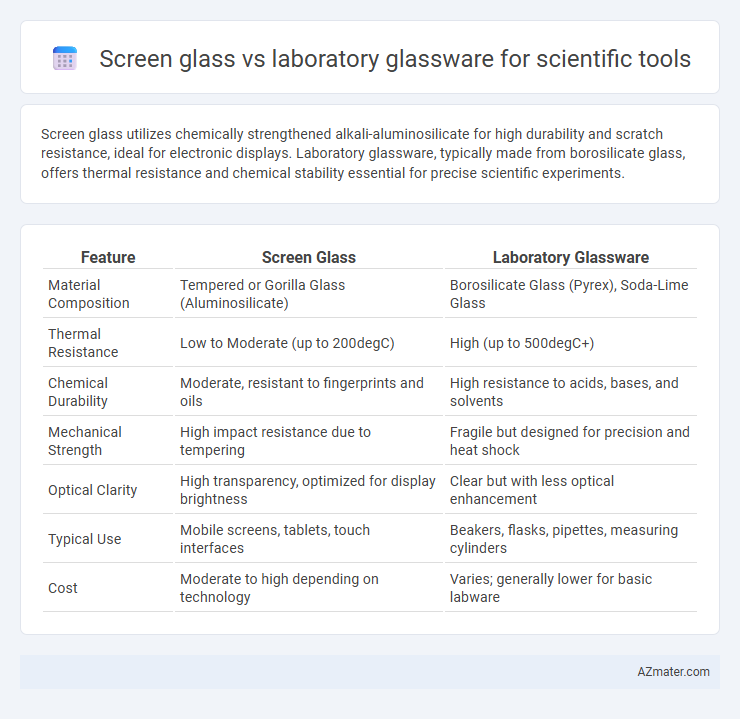Screen glass utilizes chemically strengthened alkali-aluminosilicate for high durability and scratch resistance, ideal for electronic displays. Laboratory glassware, typically made from borosilicate glass, offers thermal resistance and chemical stability essential for precise scientific experiments.
Table of Comparison
| Feature | Screen Glass | Laboratory Glassware |
|---|---|---|
| Material Composition | Tempered or Gorilla Glass (Aluminosilicate) | Borosilicate Glass (Pyrex), Soda-Lime Glass |
| Thermal Resistance | Low to Moderate (up to 200degC) | High (up to 500degC+) |
| Chemical Durability | Moderate, resistant to fingerprints and oils | High resistance to acids, bases, and solvents |
| Mechanical Strength | High impact resistance due to tempering | Fragile but designed for precision and heat shock |
| Optical Clarity | High transparency, optimized for display brightness | Clear but with less optical enhancement |
| Typical Use | Mobile screens, tablets, touch interfaces | Beakers, flasks, pipettes, measuring cylinders |
| Cost | Moderate to high depending on technology | Varies; generally lower for basic labware |
Introduction to Scientific Glassware
Scientific glassware encompasses a diverse range of products designed for precision and durability in laboratory environments, with distinctions between screen glass and laboratory glassware. Screen glass typically refers to specialized glass used in electronic displays or imaging devices, featuring unique optical properties, while laboratory glassware includes beakers, flasks, and test tubes made from borosilicate glass for chemical resistance and thermal stability. Understanding these differences is crucial for selecting the appropriate material that meets specific scientific requirements and experimental conditions.
Defining Screen Glass and Laboratory Glassware
Screen glass refers to specialized glass panels used primarily in electronic devices to protect displays while providing high transparency and durability. Laboratory glassware encompasses a variety of heat-resistant and chemically inert glass containers like beakers, flasks, and test tubes designed for conducting experiments and handling chemicals. The key distinction lies in screen glass's emphasis on optical clarity and impact resistance for electronic applications, whereas laboratory glassware prioritizes thermal stability and chemical resistance for scientific procedures.
Physical and Chemical Properties Comparison
Screen glass exhibits high durability, scratch resistance, and excellent clarity, typically manufactured from toughened or tempered soda-lime or aluminosilicate glass. Laboratory glassware, including borosilicate glass, offers superior chemical resistance, thermal stability, and low thermal expansion, essential for handling corrosive chemicals and sudden temperature changes. While screen glass prioritizes mechanical strength and optical properties, laboratory glassware emphasizes chemical inertness and heat resistance for precise scientific applications.
Durability and Strength Factors
Screen glass, typically made from chemically strengthened or tempered glass, offers high durability and scratch resistance essential for protective barriers in scientific environments. Laboratory glassware, composed primarily of borosilicate glass, excels in thermal resistance and chemical stability, enabling it to withstand rapid temperature changes and corrosive substances without breaking. The inherent strength of screen glass favors impact resistance, while laboratory glassware is engineered for thermal shock resilience and precision handling in experimental procedures.
Thermal and Chemical Resistance
Screen glass typically exhibits moderate thermal resistance, making it suitable for electronic displays but less ideal for high-temperature laboratory processes. Laboratory glassware, such as borosilicate glass, offers superior thermal shock resistance and can withstand rapid temperature changes up to 450degC without cracking. Chemically, laboratory glassware resists a wide range of acids, bases, and solvents, whereas screen glass may degrade or discolor when exposed to harsh chemicals.
Suitability for Scientific Applications
Screen glass offers superior optical clarity and scratch resistance, making it suitable for precise optical instruments in scientific settings. Laboratory glassware, typically made from borosilicate glass, excels in thermal resistance and chemical durability, essential for handling reactions and high-temperature processes. Each material's suitability depends on the specific scientific application, with screen glass favored for visual inspection and laboratory glassware preferred for chemical and thermal experiments.
Cost and Availability Analysis
Screen glass typically offers lower costs due to mass production and widespread availability in electronics markets, contrasting with laboratory glassware's higher prices driven by specialized manufacturing standards and chemical resistance requirements. Laboratory glassware, including borosilicate and quartz options, demands rigorous quality control and certifications, impacting both cost and lead times significantly. The choice between screen glass and laboratory glassware hinges on project budget limitations and the accessibility of certified scientific tools within regional supply chains.
Safety Considerations in Laboratory Use
Screen glass used in laboratory settings is typically tempered and designed to resist shattering, reducing the risk of injury during experiments involving heat or pressure. Laboratory glassware, such as borosilicate glass, is chemically durable and heat-resistant but fragile, requiring careful handling and protective equipment to prevent cuts or chemical exposure from breakage. Proper safety protocols, including the use of safety goggles and gloves, are essential to mitigate hazards when working with either material in scientific environments.
Environmental Impact and Sustainability
Screen glass, predominantly used in electronic devices, poses environmental challenges due to its energy-intensive manufacturing process and difficulties in recycling, often leading to electronic waste accumulation. Laboratory glassware, typically made from borosilicate glass, offers higher sustainability through its durability, resistance to thermal shock, and recyclability, reducing the need for frequent replacement and lowering overall environmental footprint. Choosing laboratory glassware supports sustainable scientific practices by minimizing waste and promoting resource efficiency in research environments.
Conclusion: Choosing the Right Glass for Science
Screen glass offers durability and impact resistance ideal for protecting sensitive instruments, while laboratory glassware provides chemical stability and thermal resistance critical for experiments. Selecting the right glass depends on the specific scientific application, balancing factors like mechanical strength, chemical compatibility, and temperature tolerance. Prioritizing these properties ensures optimal performance and safety in scientific tools and research environments.

Infographic: Screen glass vs Laboratory glassware for Scientific tool
 azmater.com
azmater.com